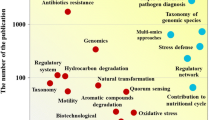Abstract
Carbonate crystal formation by 48 strains of moderately halophilic microorganisms currently assigned to the genusFlavobacterium andAcinetobacter has been investigated. Strains were grown at different salt concentrations (2.5%, 7.5%, and 20%, wt/vol, total salts) and temperatures (22°C and 32°C). All the strains tested were capable of precipitating calcium carbonate as calcite, but onlyAcinetobacter strains formed aragonite. High temperature and low ionic strength of medium favored crystal formation. The influence of species specificity on the type of crystal precipitated by moderately halophilic microorganisms and their possible role in active precipitation in nature are discussed.
Similar content being viewed by others
Literature Cited
Berry, G (ed) (1981) Selected powder diffraction data for minerals, supplement 1. Pennsylvania: J.C.P.D.S. International Center for Diffraction Data.
Billy C (1980) Problèmes poses par le metabolism de quelques bactéries calcifiantes aerobies. I. Étude d'une association bacterienne halophile productrice d'aragonite en milieu marin. Vie Milieu 30: 165–169
Boquet E, Boronat A, Ramos Cormenzana A (1973) Production of calcite (calcium carbonate) crystals by soil bacteria is a general phenomenon. Nature 246: 527–529
Cailleau P, Dragone D, Girou A, Humbert L, Jacquin C, Roques H (1977) Etude experimentale de la précipitation des carbonates de calcium in presence de l'ion magnesium. Bull Soc Fr Mineral Cristalogr 100: 81–88
Del Moral A, Roldan E, Navarro J, Monteoliva M, Ramos Cormenzana A (1987) Formation of calcium carbonate crystals by moderately halophilic bacteria. Geomicrobiol J 5: 79–87
Doetsch R, Cook TM (eds) (1973) Introduction to bacteria and their ecobiology. Lancaster: Medical and Technical Publishing
Ferrer MR, Quevedo Sarmiento J, Bejar V, Delgado R, Ramos Cormenzana A, Rivadeneyra MA (1988) Calcium carbonate formation byDeleya halophila: effect of salt concentration and incubation temperature. Geomicrobiol J, in press
Goldsmith JR, Graf DL, Heard HC (1961) Lattice constants of the calcium-magnesium carbonates. Am Miner 46: 453–457
Kamiya K, Sakka S, Tereda K (1977) Aragonite formation through precipitation of calcium carbonate monohydrate. Water Res Bull 12: 1095–1102
Kitano Y, Hood DV (1962) Calcium carbonate crystals formed from sea water by inorganic processes. J. Oceanogr Soc Japan 18: 208–219
Kitano K, Akira T, Arakaki T (1979) Magnesian calcite synthesis from calcium bicarbonate solution containing magnesium and barium ions. Geochem J 13: 181–185
Klug HP, Alexander LE (eds) (1974) X-ray diffraction procedures for polycrystalline and amorphous material. New York: John Wiley and Sons Inc
Kushner DJ (1985) The halobacteriaceae. In: Woese CR, Wolfe RS (eds) The bacteria, vol 8: Arachaebacteria New York: Academic Press, pp 171–214
McCallum MF, Guthakurta K (1970) The precipitation of calcium carbonate from seawater by bacteria isolated from Bahama Bank sediments. J Appl Bacteriol 33: 649–655
Monteoliva-Sanchez M, Ferrer MR, Ramos Cormenzana A, Quesada E, Monteoliva M (1988) J Gen Microbiol 134: 199–203
Morita RY (1980) Calcite precipitation by marine bacteria. Geomicrobiol J 2: 63–82
Novitsky JA (1981) Calcium carbonate precipitation by marine bacteria. Geomicrobiol J 2: 375–388
Quesada E, Ventosa A, Rodriguez-Valera F, Megias L, Ramos Cormenzana A (1983) Numerical taxonomy of moderately halophilic Gram-negative bacteria from hypersaline soils. J Gen Microbiol 129: 2649–2657
Quesada E, Valderrama MJ, Bejar V, Ventosa A, Ruiz-Berraquero F, Ramos Cormenzana A (1987) Numerical taxonomy of moderately halophilic Gram-negative nonmotile eubacteria. System Appl Microbiol 9: 132–137
Rivadeneyra MA, Perez-Garcia I, Salmeron V, Ramos Cormenzana A (1985a) Bacterial precipitation of calcium carbonate in presence of phosphate. Soil Biol Biochem 17: 171–172
Rivadeneyra MA, Ramos Cormenzana A, Garcia Cervigon A (1985b). Étude de l'influence du rapport Mg/Ca sur la formation de carbonate par des bacteria telluriques. Can J Microbiol 31: 229–231
Sayoko Y, Kitano Y (1985) Transformation of aragonite to calcite through heating. Geochem J 19: 245–249
Schultz LG (1964) Quantitative interpretation of microbiological composition from X-ray and chemical data for the Pierre Shale. Geol Surv Prof Paper 391-C. Washington, DC: US Government Printing Office
Subow NN (1931) Oceanographical tables. Moscow: USSR Oceanographic Institute Hydrometeorological Commission
Author information
Authors and Affiliations
Rights and permissions
About this article
Cite this article
Ferrer, M.R., Quevedo-Sarmiento, J., Rivadeneyra, M.A. et al. Calcium carbonate precipitation by two groups of moderately halophilic microorganisms at different temperatures and salt concentrations. Current Microbiology 17, 221–227 (1988). https://doi.org/10.1007/BF01589456
Issue Date:
DOI: https://doi.org/10.1007/BF01589456




